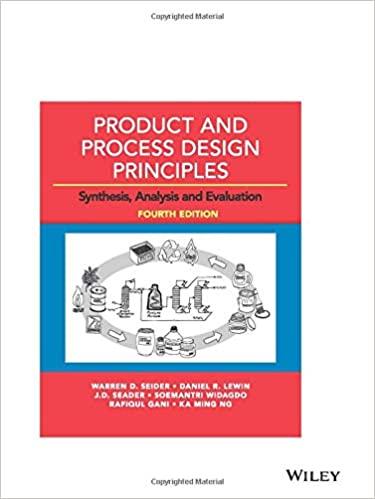A home appliances company decides to produce an all-in-one water treatment system for treating tap water. It
Question:
A home appliances company decides to produce an all-in-one water treatment system for treating tap water. It contains a filter to remove suspended solids, a reverse osmosis (RO) membrane unit to remove dissolved ions, an ultraviolet disinfection system, and a granular activated carbon filter for final polishing of taste and odor. We have been assigned to design the RO module. The water treatment system is attached to a faucet with a water flow rate of \(7.5 \mathrm{~L} / \mathrm{min}\). The water flow rate across the membrane (i.e., permeate flow rate) is directly proportional to the pressure difference \(\left(P_{f c}-P_{p}\right)\) minus the osmotic pressure difference \(\left(\pi_{f c}-\pi_{p}\right)\),
\[Q_{p}=k_{w} A\left[\left(P_{f c}-P_{p}\right)-\left(\pi_{f c}-\pi_{p}\right)\right]\]
where \(k_{w}\) is the mass-transfer coefficient of water across the membrane, \(A\) is the membrane surface area, and \(P_{f c}\) and \(P_{p}\left(\pi_{f c}\right.\) and \(\left.\pi_{p}\right)\) are the pressure (osmotic pressure) at the feed-concentrate side and the permeate side of the membrane, respectively. The osmotic pressure \(\pi\) is related to the solute concentration \(C\) as follows.
\[\pi=C R T\]
where \(R\) is the universal gas constant and \(T\) is the temperature. Similarly, the solute flow rate across the membrane is proportional to the concentration difference,
\[Q_{p} C_{p}=k_{s} A\left(C_{f c}-C_{p}\right)\]
where \(k_{s}\) is the mass-transfer coefficient of solute across the membrane and \(C_{f c}\) and \(C_{p}\) are the solute concentration in the feed-concentrate side and the permeate side of the membrane, respectively.
(a) As a measure of product performance, a solute rejection ratio \((R e j=\) \(1-C_{p} / C_{f}\) ) of \(99 \%\) is required for a feed stream with \(100 \mathrm{ppm}\) of \(\mathrm{Ca}^{2+}\). Determine the product specifications, particularly the membrane area and the permeate flowrate. The following parameters are available:
\[\begin{aligned}P_{f c} & =30 \mathrm{~atm} \\P_{p} & =1 \mathrm{~atm} \\T & =298 \mathrm{~K} \\k_{w} & =2.87 \times 10^{-3} \mathrm{~m} / \mathrm{h} \mathrm{atm} \\k_{s} & =6.14 \times 10^{-4} \mathrm{~m} / \mathrm{h}\end{aligned}\]
(b) As water passes through the membrane, solute accumulates near the membrane surface, causing concentration polarization. \(C_{f c}\) has to be modified by multiplying with a factor \(\beta\) given below.
\[\beta=\exp \left(\frac{Q_{p}}{A k_{c p}}\right) \operatorname{Rej}+(1-\operatorname{Rej})\]
where \(k_{c p}=2.2 \times 10^{-4} \mathrm{~m} / \mathrm{s}\). How does it impact the design?
Step by Step Answer:

Product And Process Design Principles Synthesis Analysis And Evaluation
ISBN: 9781119355243
4th Edition
Authors: Warren D. Seider, Daniel R. Lewin, J. D. Seader, Soemantri Widagdo, Rafiqul Gani, Ka Ming Ng





